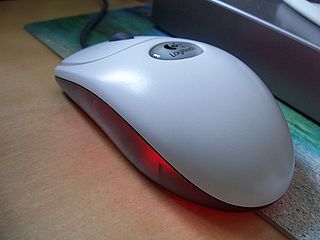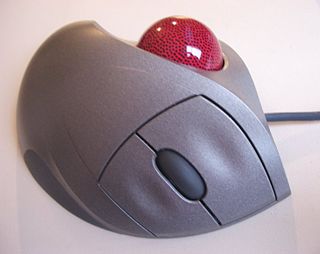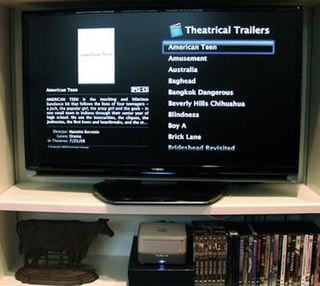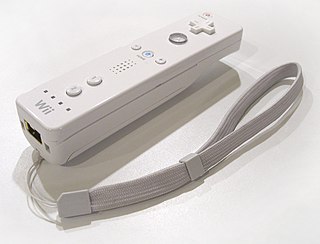
A computer mouse is a hand-held pointing device that detects two-dimensional motion relative to a surface. This motion is typically translated into the motion of the pointer on a display, which allows a smooth control of the graphical user interface of a computer.

In computing, a pointing device gesture or mouse gesture is a way of combining pointing device or finger movements and clicks that the software recognizes as a specific computer event and responds to accordingly. They can be useful for people who have difficulties typing on a keyboard. For example, in a web browser, a user can navigate to the previously viewed page by pressing the right pointing device button, moving the pointing device briefly to the left, then releasing the button.

A pointing device is a human interface device that allows a user to input spatial data to a computer. Graphical user interfaces (GUI) and CAD systems allow the user to control and provide data to the computer using physical gestures by moving a hand-held mouse or similar device across the surface of the physical desktop and activating switches on the mouse. Movements of the pointing device are echoed on the screen by movements of the pointer and other visual changes. Common gestures are point and click and drag and drop.

A trackball is a pointing device consisting of a ball held by a socket containing sensors to detect a rotation of the ball about two axes—like an upside-down ball mouse with an exposed protruding ball. Users roll the ball to position the on-screen pointer, using their thumb, fingers, or the palm of the hand, while using the fingertips to press the buttons.

A game controller, gaming controller, or simply controller, is an input device or input/output device used with video games or entertainment systems to provide input to a video game. Input devices that have been classified as game controllers include keyboards, mice, gamepads, and joysticks, as well as special purpose devices, such as steering wheels for driving games and light guns for shooting games. Controllers designs have evolved to include directional pads, multiple buttons, analog sticks, joysticks, motion detection, touch screens and a plethora of other features.

Logitech International S.A. is a Swiss multinational manufacturer of computer peripherals and software. Headquartered in Lausanne, Switzerland, and San Jose, California, the company has offices throughout Europe, Asia, Oceania, and the Americas, and is one of the world's leading manufacturers of input and interface devices for personal computers (PCs) and other digital products. It is a component of the flagship Swiss Market Index, and listed on the Nasdaq.

In computing, a zooming user interface or zoomable user interface is a type of graphical user interface (GUI) where users can change the scale of the viewed area in order to see more detail or less, and browse through different documents. Information elements appear directly on an infinite virtual desktop, instead of in windows. Users can pan across the virtual surface in two dimensions and zoom into objects of interest. For example, as you zoom into a text object it may be represented as a small dot, then a thumbnail of a page of text, then a full-sized page and finally a magnified view of the page.

A home theater PC (HTPC) or media center computer is a convergent device that combines some or all the capabilities of a personal computer with a software application that focuses on video, photo, audio playback, and sometimes video recording functionality. Since the mid-2000s, other types of consumer electronics, including game consoles and dedicated media devices, have crossed over to manage video and music content. The term "media center" also refers to specialized application software designed to run on standard personal computers.

Gesture recognition is an area of research and development in computer science and language technology concerned with the recognition and interpretation of human gestures. A subdiscipline of computer vision, it employs mathematical algorithms to interpret gestures.

The Wii Remote, informally referred to with the portmanteau Wiimote, is the primary game controller for Nintendo's Wii home video game console. An essential capability of the Wii Remote is its motion sensing capability, which allows the user to interact with and manipulate items on screen via motion sensing, gesture recognition, and pointing using an accelerometer and optical sensor technology. It is expandable by adding attachments. The attachment bundled with the Wii console is the Nunchuk, which complements the Wii Remote by providing functions similar to those in gamepad controllers. Some other attachments include the Classic Controller, Wii Zapper, and the Wii Wheel, which was originally released with the racing game, Mario Kart Wii.
Various accessories for the PlayStation 3 video game console have been produced by Sony and third-party companies. These include controllers, audio and video input devices like microphones, video cameras, and cables for better sound and picture quality.

Kinect is a discontinued line of motion sensing input devices produced by Microsoft and first released in 2010. The devices generally contain RGB cameras, and infrared projectors and detectors that map depth through either structured light or time of flight calculations, which can in turn be used to perform real-time gesture recognition and body skeletal detection, among other capabilities. They also contain microphones that can be used for speech recognition and voice control.

In computing, an input device is a piece of equipment used to provide data and control signals to an information processing system, such as a computer or information appliance. Examples of input devices include keyboards, computer mice, scanners, cameras, joysticks, and microphones.

Google TV was a smart TV operating system from Google co-developed by Intel, Sony and Logitech. It launched in October 2010 with official devices initially made by Sony and Logitech. Google TV integrated the Android 3.0/3.2 operating system and the Google Chrome web browser to create an interactive television overlay on top of existing online video sites to add a 10-foot user interface, for a smart TV experience.
VRPN is a device-independent, network-based interface for accessing virtual reality peripherals in VR applications. It was originally designed and implemented by Russell M. Taylor II at the Department of Computer Science of the University of North Carolina at Chapel Hill. VRPN was maintained and supported by Sensics while it was business. It is currently maintained by ReliaSolve and developed in collaboration with a productive community of contributors. It is described more fully at vrpn.net and in VRPN-VRST.
Kylo is a discontinued open-source web browser developed by Hillcrest Labs for Microsoft Windows and Mac OS X. Initially released in 2010, the browser features a 10-foot user interface, with large fonts and buttons that make it easy to see from across the room, making it especially suitable for use with a home theater PC connected directly to a high-definition television.

Yahoo! Smart TV was a Smart TV platform developed by Yahoo! based upon the Yahoo! Desktop Widgets (Konfabulator) platform. Yahoo! Connected TV announced on August 20, 2008, at the Intel Developer Forum in San Francisco as the Widget Channel, it integrated the Yahoo! Widgets Engine with a new television oriented user interface to enable Internet connected applications to run and display on a 10-foot user interface. The platform was slowly being abandoned by its manufacturers, and was eventually deprecated. New apps that were based on Konfabulator stopped being added effective March 30, 2018, but existing apps can still be updated and installed, and HTML5 based apps are not affected by this.

Bird is an interactive input device designed by Israel-based startup, MUV Interactive, which develops technology for wearable interfaces. Bird connects to computers to make any surface an interactive 3D environment. The device features remote touch, touchpad swipe control, gesture control, touchscreen capabilities, voice command recognition, a laser pointer, and other advanced options.

NetCast is a Smart TV platform based on Linux, built by LG Electronics that was preinstalled on their smart TVs between 2009 and 2014. LG has signed partnerships with various companies to provide services on the TV. It includes YouTube, AccuWeather, Orange Mobile, Maxdome, CinemaNow, Netflix and more apps that can be downloaded from the internet. LG has combined local and global services to provide the most relevant content. In 2011, LG added the LG Apps Store to the platform. It allowed users to install applications which were not previously included on their TVs. The platform was succeeded by WebOS.

A wireless clicker or wireless presenter is a handset remote used to control a computer during a presentation, by emulating a "mouse click" + "some keys of a PC keyboard"; usually incorporating a laser pointer to pinpoint screen details. It is mainly used for presentations with a video projector or a big TV screen, allowing the presenter to move freely in front of the audience.

















